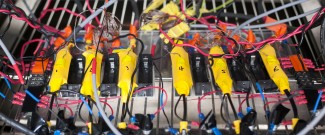
Evidence continues to suggest that energy storage may be getting cheaper and scaling up faster than once thought. A review of new research and analysis demonstrates why many observers remain confident about the market potential for energy storage, particularly when it’s coupled with solar PV installation.
Two recent reports from the National Renewable Energy Laboratory (NREL) show interesting links between energy market policy and pricing. The first report, NREL’s analysis of demand charges, analyzes over 10,000 utility tariffs in 48 states, concluding that – as their press release reads – “Five Million Commercial Customers Could Cut Costs with Energy Storage.”
Some background: Commercial electricity customers are typically billed for energy in two ways: consumption charges, the total amount of electricity used during a billing period; and demand charges, the highest level of electricity used during a billing period, aka “peak demand.” The utility uses demand charges as a way to distribute more of the costs associated with building and maintaining the capacity of its power system to the commercial users that use that power most.
Throughout the country, utilities apply demand charges with great variability, with charges depending on things such as location, size, type of building, or the customer’s need for energy at peak demand. But for commercial businesses the demand charges can account for 30 to 70 percent of the total charges on their bill. This means that businesses are looking to avoid demand charges during their peak demand needs, giving them an incentive to pursue energy storage.
The NREL researchers focus on the number of commercial customers eligible nationwide for utility rate tariffs including demand charges of $15 or more per kilowatt – an industry benchmark for identifying economic opportunities for “behind-the-meter,” or power intended for on-site use. Using this benchmark, the researchers concluded that five million commercial customers could cut their energy costs by deploying an energy storage system. Another analysis, this one by McKinsey & Company, calculated that some commercial customers could break even with an energy storage system with a demand charge of about $9 per kilowatt.
A second recent NREL study analyzed various tradeoffs among a variety of solar PV and storage configurations, specifically examining the region of Southern California. This analysis reviews, among other factors, the tax benefits from the Investment Tax Credit (ITC), but it’s worth noting that the ITC is currently only available for energy storage systems that are charged mostly from renewable energy sources. The study found solar market penetration to be an important factor, with the benefits of standalone solar beginning to weaken at about 15% solar penetration whereas, at 24% solar penetration, any combination of solar-plus-storage beats standalone solar, even without the ITC. The takeaway here is that the study projects solar-plus-storage to be cost competitive by 2020.
Finally, a recent analysis on the viability of dispatchable energy from solar coupled with battery storage highlights how research and energy innovation increase technology deployment. Published in the journal Nature Energy, the study shows that the knowledge and deployment growth of energy storage is moving faster than wind or solar did in the past. The authors use a two-factor learning curve model to analyze the impact of innovation and deployment policies on the cost of energy storage technologies, and ultimately recommend pursuing both innovation policy and deployment policy for maximum impact. Their model also finds a critical turning point of electrochemical battery storage reaching the U.S. threshold of $100kWh by 2019.
For energy storage to become mainstream in the residential and commercial sectors, we will need more research and innovation, public policy to encourage deployment, and continuous competitive price points. There is undoubtedly work to be done, and yet these three reports give reason for optimism – someday, combinations of solar, wind, and energy storage will likely compete with fossil-based electricity.

